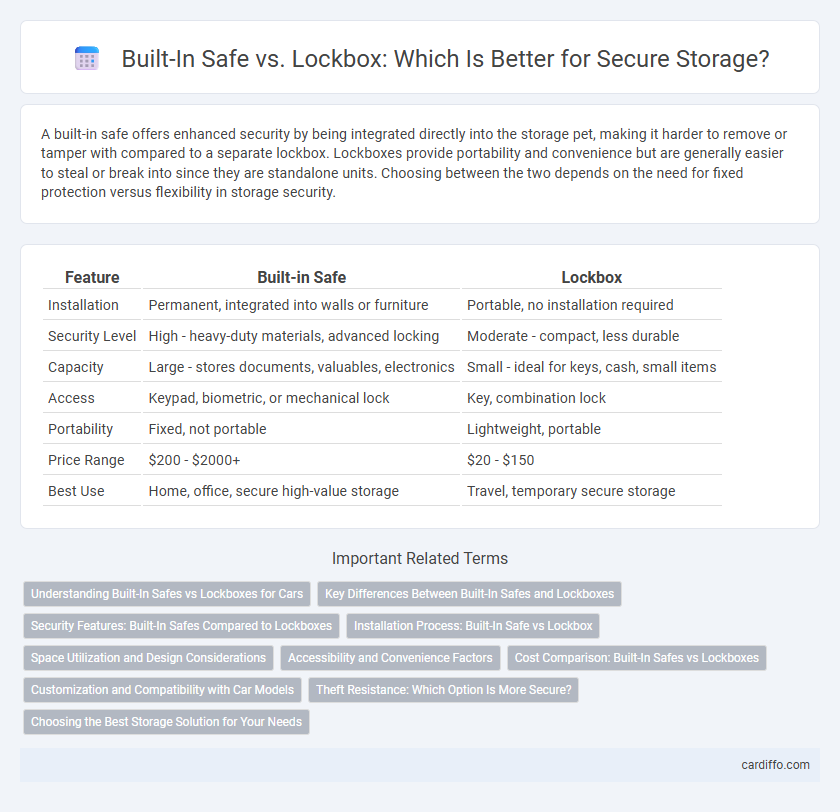A built-in safe offers enhanced security by being integrated directly into the storage pet, making it harder to remove or tamper with compared to a separate lockbox. Lockboxes provide portability and convenience but are generally easier to steal or break into since they are standalone units. Choosing between the two depends on the need for fixed protection versus flexibility in storage security.
Table of Comparison
| Feature | Built-in Safe | Lockbox |
|---|---|---|
| Installation | Permanent, integrated into walls or furniture | Portable, no installation required |
| Security Level | High - heavy-duty materials, advanced locking | Moderate - compact, less durable |
| Capacity | Large - stores documents, valuables, electronics | Small - ideal for keys, cash, small items |
| Access | Keypad, biometric, or mechanical lock | Key, combination lock |
| Portability | Fixed, not portable | Lightweight, portable |
| Price Range | $200 - $2000+ | $20 - $150 |
| Best Use | Home, office, secure high-value storage | Travel, temporary secure storage |
Understanding Built-In Safes vs Lockboxes for Cars
Built-in safes for cars offer advanced security features that are integrated into the vehicle's structure, providing protection against theft and tampering by being discreet and difficult to remove. Lockboxes, on the other hand, are portable storage containers designed for convenience and accessibility, but they may lack the same level of permanence and security as built-in safes. Choosing between these options depends on the desired balance between security, portability, and ease of access for valuable items inside a vehicle.
Key Differences Between Built-In Safes and Lockboxes
Built-in safes are integrated into walls or floors, offering enhanced security by being permanently fixed and harder to remove, whereas lockboxes are portable and provide convenience for temporary or mobile storage solutions. Built-in safes typically feature more robust construction with thicker steel and advanced locking mechanisms, making them more resistant to forced entry compared to the usually lighter and smaller lockboxes. Lockboxes excel in ease of access and transportability but lack the structural reinforcement and permanence that define built-in safes.
Security Features: Built-In Safes Compared to Lockboxes
Built-in safes offer superior security features compared to lockboxes, featuring reinforced steel construction, fire-resistant materials, and advanced locking mechanisms like biometric or electronic keypads. Unlike portable lockboxes, built-in safes are anchored to walls or floors, preventing theft through physical removal. The integration of tamper alarms and audit trails in high-end built-in safes enhances protection for valuables and sensitive documents.
Installation Process: Built-In Safe vs Lockbox
The installation process for a built-in safe involves securing it into a wall or floor cavity, requiring precise measurements and professional expertise to ensure stability and concealment. In contrast, a lockbox offers a portable, no-drill setup, easily placed in vehicles, under desks, or in cabinets without permanent modification. Choosing between the two depends on the desired level of security, permanence, and installation complexity.
Space Utilization and Design Considerations
Built-in safes maximize space utilization by seamlessly integrating into walls or furniture, providing secure storage without occupying additional floor space. Their design allows for customized dimensions and concealment options, enhancing both security and aesthetic appeal. In contrast, lockboxes are portable and versatile but often require dedicated surface or shelf space, making them less efficient for optimizing room layout.
Accessibility and Convenience Factors
Built-in safes offer superior accessibility by being permanently integrated into walls or furniture, allowing quick and discreet access to valuables. Lockboxes provide enhanced convenience through portability and ease of setup, enabling users to secure items in multiple locations without installation. Both options balance security needs with user preferences for accessibility and operational ease.
Cost Comparison: Built-In Safes vs Lockboxes
Built-in safes generally entail higher upfront costs due to professional installation and reinforced construction, often ranging from $500 to $2,000 depending on size and security features. Lockboxes provide a more affordable alternative, typically priced between $50 and $300, with portability and ease of use but offering less robust protection. Long-term value favors built-in safes for securing high-value items, while lockboxes suit budget-conscious users needing moderate security.
Customization and Compatibility with Car Models
Built-in safes offer seamless integration with specific car models, providing customized fit and enhanced security without compromising vehicle design. Lockboxes, while versatile and portable, often lack tailored compatibility, making them less ideal for permanent installation in diverse car interiors. Customization options in built-in safes ensure optimized space utilization and electronics integration tailored to the vehicle's framework.
Theft Resistance: Which Option Is More Secure?
Built-in safes offer superior theft resistance due to their reinforced steel construction and permanent installation, making them difficult to remove or break into. Lockboxes, while portable and convenient, typically feature lighter materials and simpler locking mechanisms that can be more easily compromised by burglars. For enhanced security, built-in safes provide a more robust deterrent against unauthorized access and theft.
Choosing the Best Storage Solution for Your Needs
Built-in safes offer enhanced security with seamless integration into walls or furniture, making them ideal for protecting valuable documents and electronics from theft and fire. Lockboxes provide portable, convenient storage options suitable for smaller items or temporary security needs, often featuring combination or key locks for quick access. Selecting the best storage solution depends on balancing factors such as security level, accessibility, size, and installation requirements to meet specific protection and usage demands.
built-in safe vs lockbox Infographic

 cardiffo.com
cardiffo.com